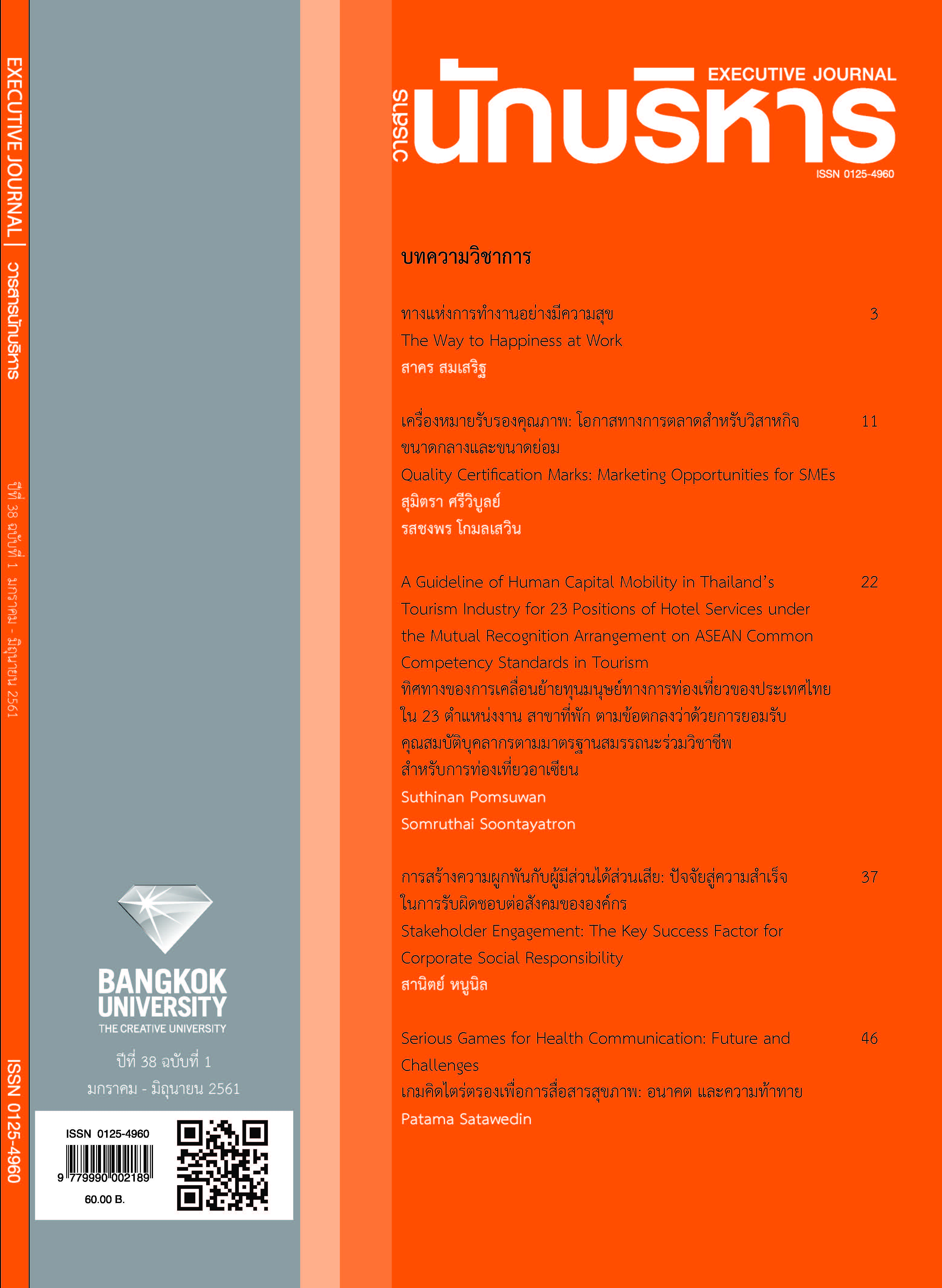The Way to Happiness at Work
Main Article Content
Abstract
This article suggests that happiness at work is an object or activity that creates physically, emotionally, and mentally comforts. It requires a person to take action rather than being determined by the environment. There are ways to help an individual enjoy the work, and that includes selecting a good career, creating love and value in work, looking at work with a creative perspective as well as working in a systematic and non-confusing ways, building friendship and unity in workplace, effective managing of stress and making great contribution to the team or to nature.
Article Details
The manuscript submitted for publication must be the original version, submitted only to this particular journal with no prior acceptance for publication elsewhere in other academic journals. The manuscript must also not violate the copyright issue by means of plagiarism.
References
Bhongmakapat, T. (2011). Kān phat tha nā khwām suk sam rap sang khom sa mai mai (Phim khrang thī 2) [Happiness development for the modern society (2nd ed.)]. Bangkok: Sangsanbooks.
Chiangkun, W. (2010). Sāt læ sinlapa nai kān pen phū nām nai lōk yuk mai [Science and art to be leaders in the new world]. Bangkok: Saithan.
Deming, W. E. (1986). Out of the crisis. Cambridge, MA: Center for Advanced Engineering Study, Massachusetts Institute of Technology.
Jumsai na Ayudhaya, A. (2011). Khrai khrai kō̜ suk dai [Everyone is happy]. Bankok: Freemind publishing.
Payutto, P. A. (2009). Siam sām trai [Siam triple three]. Bangkok: Pimsuay.
Phitchayapol, M. (2016). Khwām sam ret thāng thu ra kit [Success in business]. Dream On Volume 2 Nonthaburi: Pran Publishing.
Phucharoen, V. (2017). Suk thuk wan čhet wan čhet kū rū Tō̜n Sū kap khwām khrīat [7 Days happiness- 7 gurus-topic: How to fight stress]. Retrieved December 10, 2017, from https://www.youtube.com/watch?v=og46HOS75AY
Phutthasaphikkhu. (2013). Phāp tham kham klō̜n mī tǣ dai mai mī sīa [Picture of Dharma, gained and not lost]. Bankok: Sukkhapabjai.
Ratchabanthittayasathan. (2003). Phot čha nā nu krom Rāt cha ban thit ta ya sa thān Phō̜.Sō̜. 2542. [The Royal Institute of Thailand Encyclopedia edition, 1999]. Bangkok: Nanmeebooks Publication.
Schumacher, E. F. (2014). Ngān thī dī phưa khwām dī khwām ngām khwām čhing læ khwām bha suk khō̜ng mūan ma nut: Chut prad cha ya chœ̄ng sēt tha sāt.Pǣn dōI Somboon Suppha sin [Good work for the good merit, the beauty, the truth and the well-being of mankind: A series of economic philosophies.] (S. Suppsilp, Trans.). Bangkok: Kaenchan.
Somdetphrasangkharat, S. (1997). Su wat tha thō̜ tham [Suwatthat]. Bangkok: Songsiam.
Suwalux, A. (2017). Pai nō̜n kan ! ʻot nō̜n māk pai rawang sēn samō̜ng čha lenngān tūa ʻēng [Let's go to bed: Sleep deprivation leads to brain cells to damage itself]. Retrieved December 13, 2017, from https://www.sanook.com/men/19065/
Vajiramedhi, V. (2016). 38 Wi thīc hōk dī ta lō̜t chī wit [38 Ways to have a lucky life]. Bangkok: Sappya Publishing.
Wasi, P. (1996). Wi thī khlāI khrīat (Phim khrang thī 10) [Stress relieve methods (10th ed.)]. Bangkok: Folk Doctor.
Wisalo, W. (2015). Tham temthī tǣ mai sīreīys̄ [Do your best, but don’t take it too seriously]. Bangkok: Sappya Publishing.
Wutkhongsombat, W. (2015). Nō̜n yāng rai hai sot chưn [How do we sleep in fresh and bright ways?]. Retrieved December 12, 2017, from https://www.bangkokhealth.com/health/article


